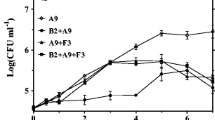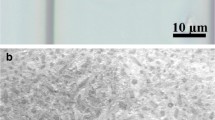Abstract
The degradation capacity of a mixed culture of Agrobacterium tumefaciens SUTS 1 and Pseudomonas monteilii SUTS 2 for thiocyanate and metal cyanide, in the form of zinc and cadmium, has been determined. The growth of a mixed culture of SUTS 1 and SUTS 2 in cyanide complexes and the cyanide removal efficiency of a fixed-film bio-column system were studied. The results showed that the mixed culture of bacteria can survive and grow in broth media containing thiocyanate and metal cyanide complexes with a maximum cell of 1.03 × 108 CFU/mL on day 3. In addition, the optimal conditions of the fixed-film bio-column system were continuously tested for 24 h, and it was found that this system had the highest removal efficiency at a flow rate of 10 mL/min and 21 min of empty bed retention time, with decreasing thiocyanate, zinc, and cadmium from 85, 0.44, and 0.044 to 65, 0.21, and 0.038 mg/L, respectively; this is in contrast to cyanide, which was not found within 12 h. Next, the conditions were maintained for 30 days, and it was found that the system had removed more than 50% of cyanide complexes, except cadmium. The complex residues were 29.96, 0.16, 0.204, and 0.085 mg/L of thiocyanate, cyanide, zinc, and cadmium, respectively. In addition, the growth of the SUTS 1 and SUTS 2 mixed culture increased. The by-product compounds sulfate and nitrate were found throughout the experiment, whereas bicarbonate and ammonia were found only on certain days.







Similar content being viewed by others
References
Ahn JH, Kim J, Lim J, Hwang SH (2004) Biokinetic evaluation and modeling of continuous thiocyanate biodegradation by Klebsiella sp. Biotechnol Progr 20(4):1069–1075. doi:10.1021/bp049967n
Ahn JH, Lee S, Hwang S (2005) Growth kinetic parameter estimation of Klebsiella sp. utilizing thiocyanate. Process Biochem 40(3–4):1363–1366. doi:10.1016/j.procbio.2004.06.004
Ahuja P, Mohapatra H, Saxena RK, Gupta R (2001) Reduced uptake as a mechanism of zinc tolerance in Oscillatoria anguistissima. Curr Microbiol 43(5):305–310. doi:10.1007/s002840010307
Akcil A (2003) Destruction of cyanide in gold mill effluents: biological versus chemical treatments. Biotechnol Adv 21(6):501–511. doi:10.1016/S0734-9750(03)00099-5
Akcil A, Mudder T (2003) Microbial destruction of cyanide wastes in gold mining: process review. Biotechnol Lett 25(6):445–450. doi:10.1023/A:1022608213814
APHA, Awwa, WPCF (1998) Standards method for the examination of water and wastewater, 20th edn. American Public Health Association, Washington
APHA, Awwa, WPCF (2005) Standards method for the examination of water and wastewater, 21st edn. American Public Health Association, Washington
Aronstein BN, Maka A, Srivastava VJ (1994) Chemical and biological removal of cyanides from aqueous and soil-containing systems. Appl Microbiol Biotechnol 41(6):700–707. doi:10.1007/BF00167288
Babu GRV, Wolfram JH, Chapatwala KD (1992) Conversion of sodium cyanide to carbon dioxide and ammonia by immobilized cells of Pseudomonas putida. J Ind Microbiol 9(3):235–238. doi:10.1007/BF01569629
Barclay M, Hart A, Knowles CJ, Meeussen JCL, Tett VA (1998) Biodegradation of metal cyanides by mixed and pure cultures of fungi. Enzym Microb Technol 22(4):223–231. doi:10.1016/S0141-0229(97)00171-3
Bergey DH, John GH (1994) Bergey’s manual of determinative bacteriology, 9th edn. Williams & Wilkins, Baltimore
Betts PM, Rinder DF, Fleeker JR (1979) Thiocyanate utilization by an Arthrobacter. Can J Microbiol 25(11):1277–1282. doi:10.1139/m79-201
Boening DW, Chew CM (1997) A critical review: general toxicity and environmental fate of three aqueous cyanide ions and associated ligands. Water Air Soil Pollut 109(1):67–79. doi:10.1023/A:1005005117439
Bose P, Bose MA, Kumar S (2002) Critical evaluation of treatment strategies involving adsorption and chelation for wastewater containing copper, zinc and cyanide. Adv Environ Res 7(1):179–195. doi:10.1016/S1093-0191(01)00125-3
Boucabeille C, Bories A, Ollivier P, Michel G (1994) Microbial degradation of metal complexed cyanides and thiocyanate from mining wastewaters. Environ Pollut 84(1):59–67. doi:10.1016/0269-7491(94)90071-X
Chakraborty S, Veeramani H (2006) Effect of HRT and recycle ratio on removal of cyanide, phenol, thiocyanate and ammonia in an anaerobic–anoxic–aerobic continuous system. Process Biochem 41(1):96–105. doi:10.1016/j.procbio.2005.03.067
Chapatwala KD, Babu GR, Vijaya OK, Kumar KP, Wolfram JH (1998) Biodegradation of cyanides, cyanates and thiocyanates to ammonia and carbon dioxide by immobilized cells of Pseudomonas putida. J Ind Microbiol Biotechnol 20(1):28–33. doi:10.1038/sj.jim.2900469
Dash RR, Balomajumder C, Kumar A (2009) Removal of metal cyanides from aqueous solutions by suspended and immobilized cells of Rhizopus oryzae (MTCC 2541). Eng Life Sci 9(1):53–59. doi:10.1002/elsc.200700024
Dursun AY, Aksu Z (2000) Biodegradation kinetics of ferrous (II) cyanide complex ions by immobilized Pseudomonas fluorescens in a packed bed column reactor. Process Biochem 35(6):615–622. doi:10.1016/S0032-9592(99)00110-7
Dzombak DA, Ghosh RS, Wong-Chong GM (2006) Cyanide in water and soil: chemistry, risk, and management. CRC Press, United States, pp 93–121
Ebbs S (2004) Biological degradation of cyanide compounds. Curr Opin Biotechnol 15(3):231–236. doi:10.1016/j.copbio.2004.03.006
EPA (1997) Methylene bis (Thiocyanate). United States Environmental Protection Agency, EPA-738-F-97-005
Grigor’eva NV, Smirnova YV, Dulov LE (2009) Thiocyanate decomposition under aerobic and oxygen-free conditions by the aboriginal bacterial community isolated from the waste water of a metallurgical works. Microbiology 78(4):402–406. doi:10.1134/S002626170904002X
Gurbuz F, Ciftci H, Akcil A (2009) Biodegradation of cyanide containing effluents by Scenedesmus obliquus. J Hazard Mater 162(1):74–79. doi:10.1016/j.jhazmat.2008.05.008
Huddy RJ, van Zyl AW, van Hille RP, Harrison STL (2015) Characterisation of the complex microbial community associated with the ASTER™ thiocyanate biodegradation system. Miner Eng 76:65–71. doi:10.1016/j.mineng.2014.12.011
Hung CH, Pavlostathis SG (1997) Aerobic biodegradation of thiocyanate. Water Res 31(11):2761–2770. doi:10.1016/S0043-1354(97)00141-3
Hung CH, Pavlostathis SG (1999) Kinetics and modeling of autotrophic thiocyanate biodegradation. Biotechnol Bioeng 62(1):1–11
Ingles J, Scott JS (1987) State of the art processes for the treatment of gold mill effluents: Industrial programs branch. Environment Canada, Ottawa
Jeong YS, Chung JS (2006) Biodegradation of thiocyanate in biofilm reactor using fluidized-carriers. Process Biochem 41(3):701–707. doi:10.1016/j.procbio.2005.09.004
Kacer Y, Arpa C, Tan S, Denizli A, Genc O, Arica MY (2002) Biosorption of Hg (II) and Cd (II) from aqueous solutions: comparison of biosorptive capacity of alginate and immobilized live and heat inactivated Phanerochaete chrysosporium. Process Biochem 37(6):601–610. doi:10.1016/S0032-9592(01)00248-5
Karavaiko GI, Kondrat’eva TF, Savari EE, Grigor’eva NV, Avakyan ZA (2000) Microbial degradation of cyanide and thiocyanate. Microbiology 69(2):167–173. doi:10.1007/BF02756193
Kwon HK, Woo SH, Park JM (2002) Thiocyanate degradation by Acremonium strictum and inhibition by secondary toxicants. Biotechnol Lett 24(16):1347–1351. doi:10.1023/A:1019825404825
Lim J, Lee S, Kim SD, Hwang S (2008) Biochemical indication of microbial mass changes using ATP and DNA measurement in biological treatment of thiocyanate. Appl Microbiol Biotechnol 80(3):525–530. doi:10.1007/s00253-008-1601-4
Lima AIG, Corticeiro SC, de Figueira EM (2006) Glutathione-mediated cadmium sequestration in Rhizobium leguminosarum. Enzym Microb Technol 39(4):763–769. doi:10.1016/j.enzmictec.2005.12.009
Limcharoensuk T, Sooksawat N, Sumarnrote A, Awutpet T, Kruatrachue M, Pokethitiyook P, Auesukaree C (2015) Bioaccumulation and biosorption of Cd2+ and Zn2+ by bacteria isolated from a zinc mine in Thailand. Ecotoxicol Environ Saf 122:322–330. doi:10.1016/j.ecoenv.2015.08.013
Liu J, Baozhen W, Li W, Chengji J, Cao X, Wang L (1996) Removal of nitrogen from coal gasification and coke plant wastewaters in A/O submerged biofilm-activated sludge (SBF-AS) hybrid system. Water Sci Technol 34(10):17–24. doi:10.1016/S0273-1223(96)00692-0
Mago R, Srivastava S (1994) Uptake of zinc in Pseudomonas sp. Strain UDG26. Appl Environ Microbiol 60(7):2367–2370
Malik A, Jaiswal R (2000) Metal resistance in Pseudomonas strains isolated from soil treated with industrial wastewater. World J Microbiol Biotechnol 16(2):177–182. doi:10.1023/A:1008905902282
Medwith BW, Lefelhocz JF (1981) Single-stage biological treatment of coke plant wastewater with a hybrid suspended growth fixed film reactor. In: Proceeding Ind. Waste Conf.; (United States); annual Purdue industrial waste conference, Lafayette, IN, USA, pp 68–76
Melcer H, Nutt SG (1988) Nitrogen control of complex industrial wastewaters. J Environ Eng ASCE 114(1):166–178. doi:10.1061/(ASCE)0733-9372
Moran RE (1998) Cyanide uncertainties: observations on the chemistry, toxicity and analysis mining-related waters. Mineral policy center issue paper No.1, Washington
Moran RE (2017) Cyanide in mining: some observations on the chemistry, toxicity and analysis mining-related waters. https://www.earthworksaction.org/files/publications/morancyanidepaper.pdf. Accessed 27 March 2017
Mudder TI, Botz MM, Smith A (2001) Chemistry and treatment of cyanidation wastes, 2nd edn. Mining Journal Books Limited, London
Nies DH (1999) Microbial heavy-metal resistance. Appl Microbiol Biotechnol 51(6):730–750
Notification the Ministry of Science, Technology and Environment (1996) No. 3, B.E. 2539 issued under the Enhancement and Conservation of the National Environment Quality Act B.E. 2535-1992, published in the Royal Government Gazette, Vol. 113 Part 13 D, dated February 13, B.E. 2539–1996
Ozgur C, Aysel U (2012) Bio-monitoring of heavy metal resistance in Pseudomonas and Pseudomonas related genus. J biol Environ Sci 6(18):233–242
Paruchuri YL, Shivaraman N, Kumaran P (1990) Microbial transformation of thiocyanate. Environ Pollut 68(1–2):15–28. doi:10.1016/0269-7491(90)90011-Z
Patil YB, Paknikar KM (2000) Development of a process for biodetoxification of metal cyanides from waste waters. Process Biochem 35(10):1139–1151. doi:10.1016/S0032-9592(00)00150-3
Plumlee GS, Smith KS, Mosier EL, Ficklin WH, Montour M, Briggs PH, Meier AL (1995) Geochemical processes controlling acid-drainage generation and cyanide degradation at Summitville. In: Proc, Summitville Forum, Colo. Geological survey special publication 38:23–34
Potivichayanon S, Kitleartpornpairoat R (2014) Degradation of cyanide to ammonia and nitrate by mixed culture of Agrobacterium tumefaciens SUTS 1 and Pseudomonas monteilii SUTS 2. In: Proceeding of the European Conference on Sustainability, energy and the environment. Brighton, United Kingdom. pp 251–264
Ragan HA, Mast TJ (1990) Cadmium inhalation and male reproductive toxicity. Rev Environ Contam Toxicol 114:1–22. doi:10.1007/978-1-4612-3368-8_1
Raja CE, Anbazhagan K, Selvam GS (2006) Isolation and characterization of a metal-resistant Pseudomonas Aeruginosa Strain. World J Microbiol Biotechnol 22(6):577–585. doi:10.1007/s11274-005-9074-4
Ryu BG, Kim J, Yoo G, Lim JT, Kim W, Han JI, Yang JW (2014) Microalgae-mediated simultaneous treatment of toxic thiocyanate and production of biodiesel. Bioresource Technol 158:166–173. doi:10.1016/j.biortech.2014.01.128
Sannasi P, Kader J, Othman O, Salmijah S (2009) Physical growth and biomass characterization of bacterial cells exposed to Cd(II), Cr(VI), Cu(II), Ni(II) and Pb(II). J Environ Res Develop 4(1):8–18
Shivaraman N, Kumaran P, Pandey RA, Chatterjee SK, Chowdhary KR, Parhad NM (1985) Microbial degradation of thiocyanate, phenol and cyanide in a completely mixed aeration system. Environ Pollut Ser A 39(2):141–150. doi:10.1016/0143-1471(85)90012-1
Silva-Avalos J, Richmond MG, Nagappan O, Kunz DA (1990) Degradation of the metal-cyano complex tetracyanonickelate (II) by cyanide-utilizing bacterial isolates. Appl Environ Microbiol 56(12):3664–3670
Sirianuntapiboon S, Chuamkaew C (2007) Packed cage rotating biological contactor system for treatment of cyanide wastewater. Bioresour Technol 98(2):266–272. doi:10.1016/j.biortech.2006.01.014
Sorokin DY, Tourova TP, Lysenko AM, Kuenen JG (2001) Microbial thiocyanate utilization under highly alkaline conditions. Appl Environ Microbiol 67(2):528–538. doi:10.1128/AEM.67.2.528-538.2001
Souza-Fagundes EM, Rosa LH, Gomes NCM, Santos MH, Pimentel PF (2004) Thiocyanate degradation by pure and mixed cultures of microorganisms. Braz J Microbiol 35(4):333–336. doi:10.1590/S1517-83822004000300012
Staden JF, Saling C, Malan D, Taljaard RE (1997) Non-linearity with metal ligand complex reactions in flow injection system. Metal-thiocyanate reactions. Analytica Chimica Acta 350:37–50. doi:10.1016/S0003-2670(97)00173-6
Supromin N, Potivichayanon S, Toensakes R (2015) Degradation of metal cyanide from real electroplating wastewater by mixed culture of SUTS 1 and SUTS 2. 3rd International conference on biological, chemical & environmental sciences (BCES-2015). Kuala lumper, Malaysia 3:75–80
Vijayaraghavan K, Yun YS (2008) Bacterial biosorbents and biosorption. Biotechnol Adv 26(3):266–291. doi:10.1016/j.biotechadv.2008.02.002
Whitlock JL (1990) Biological detoxification of precious metal processing wastewaters. Geomicrobiol J 8(3–4):241–249. doi:10.1080/01490459009377896
Wood PA, Kelly PD, McDonald RI, Jordan LS, Morgan DT, Khan S, Murrell JC, Borodina E (1998) A novel pink pigmented facultative methylotroph, Methylobacterium thiocyanatum sp. nov., capable of growth of thiocyanate or cyanate as sole nitrogen sources. Arch Microbiol 169:148–158
Acknowledgements
This research was supported and funded by Suranaree University of Technology, Nakhon Ratchasima, Thailand.
Author information
Authors and Affiliations
Corresponding author
Ethics declarations
Conflict of interest
The authors declare that they have no conflict of interest.
Rights and permissions
About this article
Cite this article
Potivichayanon, S., Supromin, N. & Toensakes, R. Development of a mixed microbial culture for thiocyanate and metal cyanide degradation. 3 Biotech 7, 191 (2017). https://doi.org/10.1007/s13205-017-0814-6
Received:
Accepted:
Published:
DOI: https://doi.org/10.1007/s13205-017-0814-6




